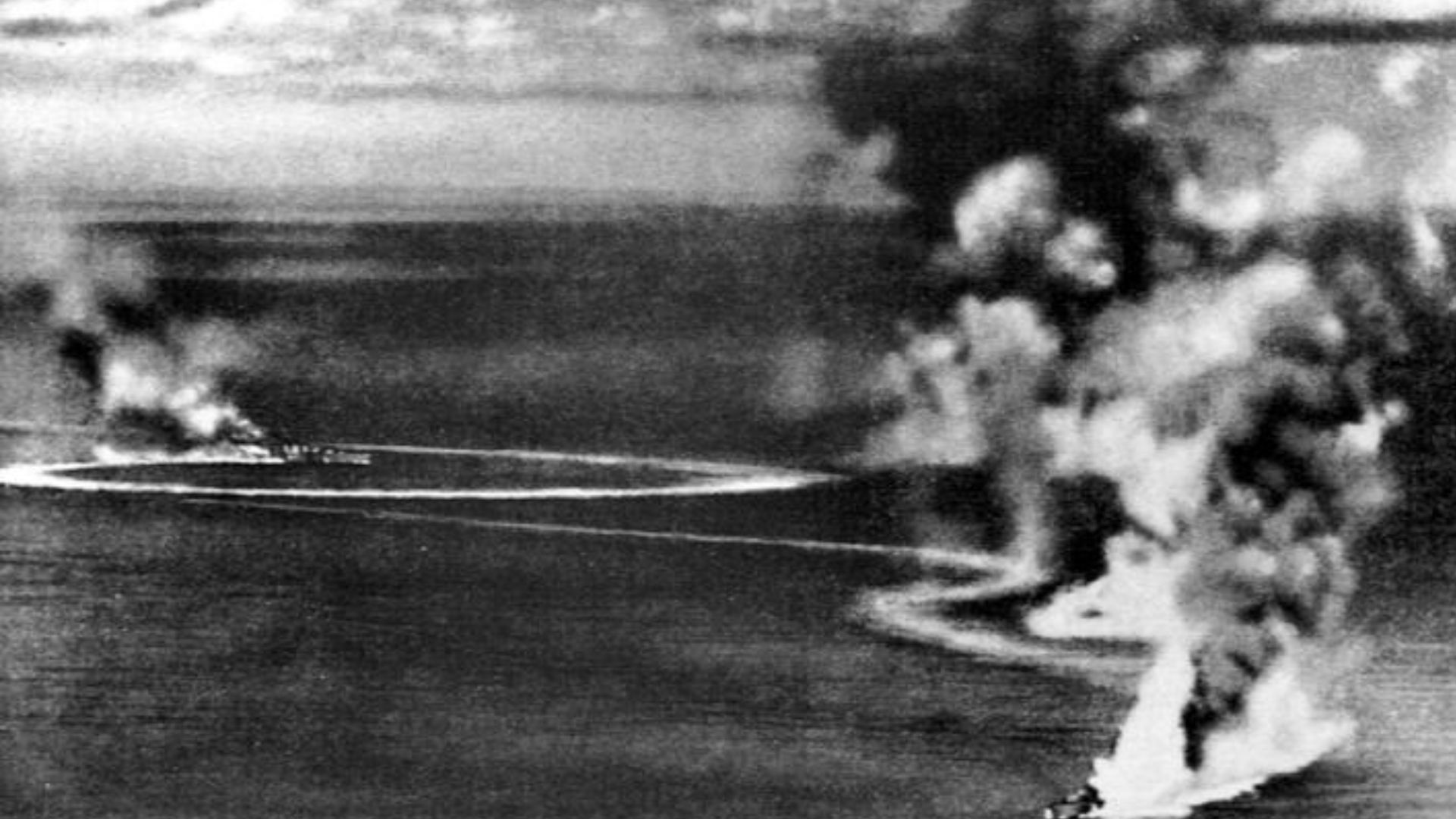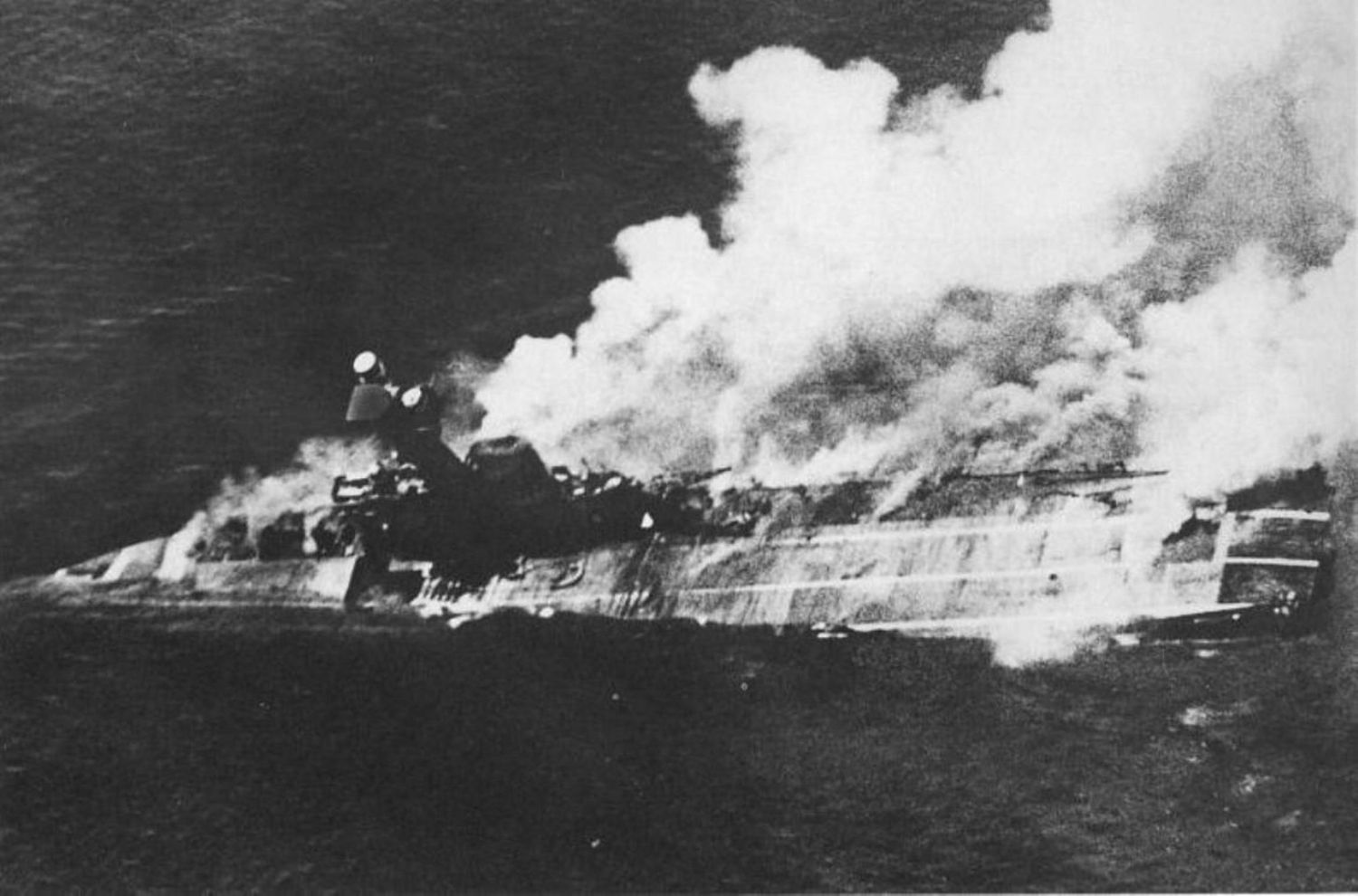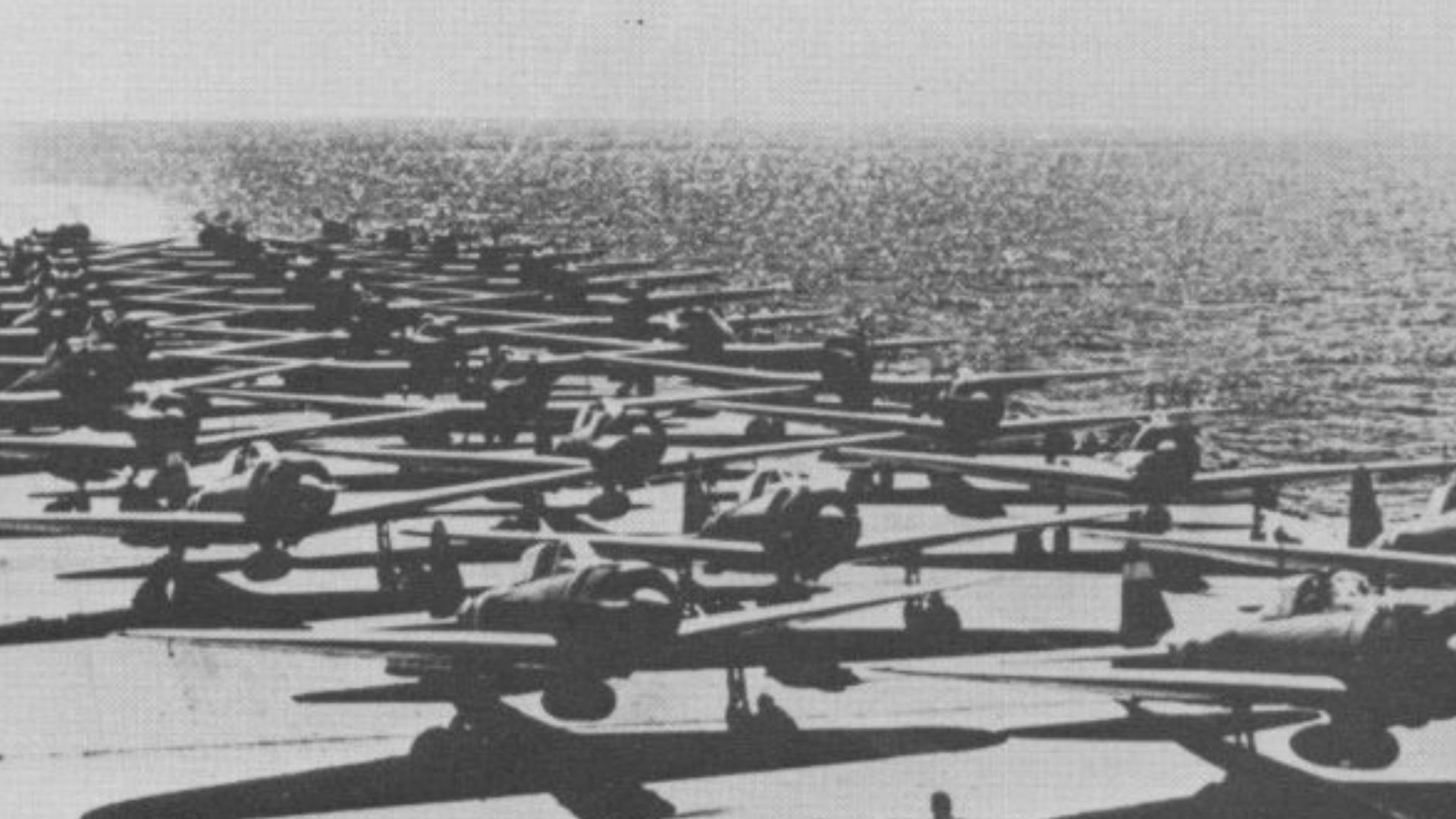
The Imperial Japanese Navy (IJN) launched the Indian Ocean raidfrom March 31, 1942, to April 10, 1942. It was also known as Operation C or the Battle of Ceylon in Japanese. Admiral Chūichi Nagumo led the Japanese aircraft carriers that attacked Allied ships and military sites near Ceylon. They were not able to find and destroy most of the British Eastern Fleet, though.
The Eastern Fleet, led by Admiral Sir James Somerville, was warned by intelligence and left its bases before the raid. However, bad tactical intelligence stopped its attack on the Japanese. The British thought that Japan would launch a big assault on the Indian Ocean after the attack.
The Eastern Fleet's main base was moved to East Africa, and Ceylon was made more robust. However, Somerville kept Force A, his fast carrier division, "in Indian waters, to be ready to deal with any attempt by the enemy to command those waters with light forces only." They didn't have any short-term plans to build on their success, though, and by the end of the year, actions in the Pacific made it impossible for them to do so.
Background Of Indian Ocean Raid
It's essential to look at the war in the Pacific and Southeast Asia as a whole in order to understand the setting of this action.
Strategic Situation
Because it looked out over the Indian Ocean, the island of Ceylon was strategically important. So, it controlled the roads that went to India, the oilfields of the Persian Gulf, and the essential trade paths that the Allies used to get to the Middle East.
Most of the rubber supplies of the British Empire were in Ceylon. Trincomalee, a vital harbor and military base, was on the eastern coast of the island. Some Sinhalese people were affected by Japanese lies, and they were now waiting for them to arrive.
Japanese Preparations
On March 9, 1942, Admiral Isoroku Yamamoto gave the southern force of the IJN, led by Admiral Nobutake Kondō, the first order to start Operation C. By March 16; the plan was to leave Staring Bay, Celebes, on March 26 for an attack on Colombo on April 5 (also known as "C day").[5] The Japanese thought they could destroy the British Eastern Fleet while it was in port.
British Preparations
In 1942, the Japanese fought in the Northern Indian Ocean and the Bay of Bengal. At the bottom of the map, you can see Nagumo's troops. Transfers from Britain and the Mediterranean were needed to strengthen the British Eastern Fleet. This was because the Royal Navy (RN) had to deal with busy war zones and high demand for its resources.
When the danger from Japan was looked at again in late December 1941, it was decided that most of the RN's big units would be moved to the Eastern Fleet. The battle line of the US Pacific Fleet was damaged at Pearl Harbor, leaving the weak troops in Malaya open to attack.
This made things more urgent. Heavy units were opened up when the United States sent more troops to the Atlantic. In the late 1930s, building projects were also beginning to produce new large units. Due to heavy losses in that theater in 1941, the Mediterranean brought in a lot fewer troops than was planned.
Why The Indian Ocean Raid Happen
The Indian Ocean raid, also known as Operation C, was part of Japan's plan to take over more land in the Pacific and Indian Oceans during World War II. There was a raid in April 1942, not long after the Japanese attacked Pearl Harbor and won, which led to a string of wins in Southeast Asia, including taking Singapore. A number of reasons influenced the Japanese choice to launch the raid into the Indian Ocean.
- Strategic Objectives - The Japanese wanted to set up a defense barrier around the new lands they had taken over in Southeast Asia and keep them safe. They wanted to stop sending goods to China and get a better grip on the resources in the area.
- Neutralize Allied Presence - The British Eastern Fleet, which was based in Ceylon (now Sri Lanka), could have been a threat to Japanese activities. By attacking the fleet before it arrived, the Japanese hoped to stop or significantly weaken the presence of Allied ships in the Indian Ocean.
- Isolation of Australia - By controlling the sea routes in the Indian Ocean, Japan tried to keep Australia from getting help from the Allies. Because of this, it would be harder for the Allies to replenish or restock Australia.
- Consolidation of Gains - The raid in the Indian Ocean was part of a larger plan by the Japanese to build a defense around their wins. The Japanese tried to protect their southern edge and keep control of vital sea lanes by protecting the Indian Ocean.
As part of the raid, British military ships in and around Ceylon were attacked from the air. Even though the Japanese were able to sink a few ships and damage some facilities, the operation did not change the balance of power in the Indian Ocean in a big way. Even though it was damaged, the British Eastern Fleet kept working, and the Japanese did not take over the whole area.
Continuing Pressure In The Indian Ocean
World War II Data BaseThe German military staff asked the Japanese Navy to attack Allied ships in the Indian Ocean in late March 1942. By the first week of April, several Japanese subs were working as far west as the seas south of South Africa.
The Japanese actions in the Indian Ocean messed up an important trade route for the Allies along the eastern coast of Africa. This made people nervous when the Allies attacked Madagascar.
By June, Japanese subs in the area were focused on the Mozambique Channel, which is between Africa and Madagascar. By mid-July 1942, they had sunk ships worth 120,000 tons. Japan's foray into the Indian Ocean paid off, but the South Pacific was where they were really fighting the war, so when the subs were taken out to refuel in the fall of 1942, they never came back in large numbers.
Two Cruisers Discovered
When Fuchida got back to the Akagi, he stomped up to the flag bridge to tell Nagumo what had happened and asked that spy planes be sent to find the British ships that had left the harbor. Nagumo didn't need to be told what to do. He sent out search planes to look for the ships that went missing.
Two of them had already left. Sister cruisers Dorsetshire and Cornwall, both from the British County class, left Colombo the night before at 10 p.m. and were going southwest at 23 knots.
The top officer was Captain Augustus Agar of Dorsetshire. He won the Victoria Cross for torpedoing a Russian ship in 1919 when the Royal Navy briefly stepped in to help the Bolsheviks.
He was told to meet up with Somerville's Force A. Agar told his ships to speed up to 26 knots after looking at his orders and the big map in the chat room. When he heard that the Japanese were 150 miles east of him, he told them to speed up to 28 knots.
"It Was Like Turning A Hand, It Was So Easy."
At noon, Dorsetshire's radar picked up Egusa's planes, and Agar radioed Somerville to let him know. Even though Somerville's big ships were only 70 miles away from Dorsetshire and Cornwall, Agar's message got to Somerville's flagship, the Warspite, in a broken state, and it took almost an hour to figure out where it came from.
The Japanese hit the two heavy ships at the same time. Agar remembered, "They came at us out of the sun in waves of three." "The first one went straight for Cornwall and scored a hit behind... as soon as it was seen."
The next three hit us straight on. As the dark and shiny 1,000-pound bombs fell, we could see them. I told them to turn the helm more than 25 degrees. Even so, the first one hit close to the launch and set fire to something. We were thrown to the deck when the next one hit close to the bridge... "...and it took down the main wireless office, which stopped more reports from getting to the C-in-C."
Impact Of The Indian Ocean Raid
The Indian Ocean raid, also known as Operation C, changed the course of World War II in the Asia-Pacific area in many essential ways. Here are some important things that happened because of the raid.
Weakening Of British Naval Power
The raid did a lot of damage to the British Eastern Fleet. The British Navy's ability to fight in the Indian Ocean was weakened when the aircraft carrier HMS Hermes and other ships sank.
Japanese Naval Dominance
Japan had a time when its military power in the Indian Ocean was unmatched right after the raid. In the early stages of the war, people thought the Japanese were unbeatable because the raid went so well.
Strategic Reevaluation
Because of the raid, the Allies, especially the British, had to rethink their military plans in the Indian Ocean. It showed how weak military bases are and how much better cooperation and intelligence are needed.
Impact On Allied Shipping
Both the raid and the action of Japanese submarines made it harder for Allied ships to sail in the Indian Ocean. This slowed down the flow of goods to the Allies and made it harder to keep contact and supply lines open.
Rebuilding The British Eastern Fleet
The British were able to rebuild their Eastern Fleet over time, even though they lost ships in the raid. New ships were put into service, and the British continued to help fight the Japanese Navy in the area.
Impact On Ceylon (Sri Lanka)
The raids did a lot of damage to the cities of Colombo and Trincomalee, which were their primary targets. But, the raids did not mean that Japanese troops would stay in Ceylon for a long time.
The Shift In Naval Dynamics
The Japanese had some military wins in the Indian Ocean, but the raid did not change the balance of power in the area as a whole. Over time, the Allies, especially the United States, were able to take the lead because their navy power kept growing.
Wider Strategic Implications
Japan's plan for the Indian Ocean raid was part of a larger plan to build a defense wall around the new lands it had taken over. The raid did not stop further Allied progress in the Pacific, though, and the war slowly turned against Japan.
Broader Context Of Raid On Indian Ocean
The Indian Ocean raid, also known as Operation C, was an essential part of World War II as a whole, especially in the Pacific War and World War II settings. To understand the bigger picture, you have to look at the military and global situations at the time.
Japanese Expansion In The Pacific
The raid happened at a time when Japan was expanding its control over the Asia-Pacific area. Japan quickly took over a number of areas after the attack on Pearl Harbor in December 1941. These included the Philippines, Malaya, Singapore, and the Dutch East Indies. The goal was to make the Greater East Asia Co-Prosperity Sphere, which would be a Japanese-controlled area of influence.
Strategic Significance Of The Indian Ocean
Both the Axis and the Allies needed to be able to control the Indian Ocean. The Indian Ocean sea lanes were vital for moving troops and goods between the Asia-Pacific region, Africa, and the Middle East. The Japanese wanted to take control of the area to protect the areas they had taken over and to stop the Allies from getting supplies.
Global Maritime Theater
The raid in the Indian Ocean was part of the larger war at sea in World War II. Naval actions in the Pacific and Indian Oceans used a lot of airpower from aircraft carriers, attacks by both land and sea and strategic decisions about who controlled the sea paths.
Allied Response And Rebuilding
The Allies, especially the British, rethought and increased their naval position in the Indian Ocean after the raid's success. Even though they lost ships, the British were able to rebuild their Eastern Fleet over time. This shows how strong the Allies' marine forces were.
Turning Points In The Pacific War
The raid happened at a time when Japan was having success in the Pacific, but it also marked the start of a change in the strategic balance. Japan lost the Battle of Midway in June 1942, just a few months after the raid in the Indian Ocean. It was a significant setback for Japan and a turning point in the Pacific War.
Indian Ocean Raid - FAQs
What Happened In India On April 6, 1942?
On April 6, 1942, the Japanese attacked the Royal Indian Navy's ship INS Prabhavati near the Andaman Islands.
Which Royal Indian Navy Warship Was Attacked By The Japanese On April 6 1942?
The Japanese attacked the Royal Indian Navy warship HMS Cornwall on the same day.
Was April 6, 1942, Attacked By The Japanese?
Yes, April 6, 1942, witnessed Japanese attacks.
Did The Royal Navy Sink Any Japanese Ships?
The Royal Navy sank several Japanese ships during the conflict, including engagements in the Pacific and Indian Oceans.
Conclusion
As we reflect on the Indian Ocean Raid, its echoes linger in the historical corridors, reminding us of the intricate interplay between military strategies, economic interests, and geopolitical ambitions. The raid reshaped the dynamics of naval warfare, influencing the course of World War II and leaving a lasting impact on the geopolitical landscape.
The lessons learned from the Indian Ocean Raid reverberate in contemporary maritime doctrines, emphasizing the need for a comprehensive understanding of geopolitical realities and the importance of securing vital sea routes. The economic interests that fueled the conflict remain relevant today, underscoring the enduring significance of the Indian Ocean as a geopolitical hotspot.


